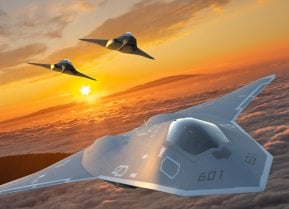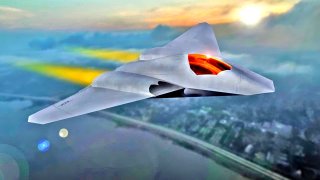Can NGAD Avoid Becoming the New F-35?
The NGAD could be a real game changer but costs and potential problems like the F-35 suffered through are something the Air Force must worry about.
Air Force Seeks to Avoid F-35 Mistakes With NGAD Fighter - A single company will be chosen next year to lead the United States Air Force's Next Generation Air Dominance (NGAD) fighter, Air Force Secretary Frank Kendall said earlier this year when he met with the Defense Writers Group.
He noted that just one defense contractor will take the lead as overall designer and developer, even as multiple companies have worked on different designs.
The Air Force seeks to avoid the costly mistakes that plagued past programs, including the F-35 Joint Fight Strike fighter.
In other words, the service doesn't want too many cooks in the kitchen and doesn't want the resulting aircraft to be akin to a camel – as in a horse designed by committee.
Kendall said that while there will be ongoing competition to supply NGAD's systems, an overall winner will be picked – a noted reversal from the original NGAD concept that had called for rolling competitions, which could produce a series of incrementally better platforms. That was revealed to be too costly.
"We're not going to do two NGADs. We're only going to do one," Kendall said at a meeting of the Defense Writers Group in Washington, D.C., per Air & Space magazine.
The NGAD is expected to replace the Air Force's fifth-generation Lockheed Martin F-22 Raptor within the next decade.
However, the NGAD is more than a single aircraft. It will include a sixth-generation manned aircraft and unmanned Collaborative Combat Aircraft (CCA) also previously known as Loyal Wingmen.
Earlier this year, the Air Force requested $1.9 billion in research and development funds for the NGAD project in its 2024 budget request to Congress.
Two Become One for NGAD
Kendall told the reporters earlier this year that he had visited Wright-Patterson Air Force Base (AFB) in Dayton, Ohio, the home of the NGAD program office.
During his visit, he saw a government engineer "working directly with one of the two contractors. He was on one of the teams and interfacing with them on the design."
The U.S. Air Force is essentially "living in the same design space" as the companies, and "They have direct access into the database that's being used for the design," Kendall added. However, the secretary did not specify who the contractors are, or what he was looking at—just that there were two contractors, Defense One reported.
There is speculation that it would likely be Lockheed Martin, which produces the F-35 and the F-16; or Boeing, the manufacturer of the F/A-18 and F-15. Those are the only two U.S. firms that currently produce jet fighters. However, Northrop Grumman is the lead contractor on the Air Force's new B-21 Raider bomber and is also a major supplier to both the F-35 and F/A-18 programs.
Avoiding the F-35 Missteps
At the event, Kendall further said the NGAD will seek to avoid past issues, notably those of the F-35.
"We're not going to repeat the, what I think frankly was a serious mistake that was made in the F-35 program" of not obtaining rights to all the fighter's sustainment data from contractor Lockheed Martin, Kendall said.
The F-35 program, which was launched more than two decades ago, utilized the Total System Performance acquisition philosophy. Under that approach, the contractor that won a program would own it for its entire lifecycle.
"What that basically does is create a perpetual monopoly," Kendall explained "I spent years struggling to overcome acquisition malpractice [on the F-35], and we're still struggling with that to some degree. So we're not going to do that with NGAD."
Latest Solicitation to Industry
Kendall's remarks months back came just days after the Department of the Air Force released a classified solicitation to industry, which provided the expected requirements of the program, with a contract award expected next year.
"The NGAD Platform is a vital element of the Air Dominance family of systems which represents a generational leap in technology over the F-22, which it will replace," Kendell said in the statement announcing the solicitation. "NGAD will include attributes such as enhanced lethality and the ability to survive, persist, interoperate, and adapt in the air domain, all within highly contested operational environments. No one does this better than the U.S. Air Force, but we will lose that edge if we don't move forward now.
The Department of the Air Force noted that this solicitation release formally begins the source selection process providing industry with the requirements it expects for NGAD, as the future replacement of the F-22 Raptor.
"The NGAD acquisition strategy will invigorate and broaden the industrial base to deliver rapid and innovative warfighting capabilities," the Air Force also stated. It further suggested that strategy incorporates lessons learned from recent Air Force acquisition programs and will leverage open architecture standards. The approach is meant to enable the government to maximize competition throughout the life cycle, provide a larger, more responsive industry base and drastically reduce maintenance and sustainment costs.
In addition, the NGAD Platform was stated to be just one of many critical combat capabilities that will enable counter-air missions with the ability to strike both airborne and ground-based threats to achieve air superiority and support the Joint Force. Moreover, the NGAD Platform's technical and programmatic details remain classified to protect operational and technological advantages.

It was also noted that the CCA program is not part of this NGAD Platform source selection. Kendall has said that the NGAD and CCA will be developed "in parallel," yet he has declined to say when a contract award for the CCA program might be awarded.
Author Experience and Expertise
Peter Suciu is a Michigan-based writer. He has contributed to more than four dozen magazines, newspapers, and websites with over 3,200 published pieces over a twenty-year career in journalism. He regularly writes about military hardware, firearms history, cybersecurity, politics, and international affairs. Peter is also a Contributing Writer for Forbes and Clearance Jobs. You can follow him on Twitter: @PeterSuciu.
All images come from Shutterstock.


